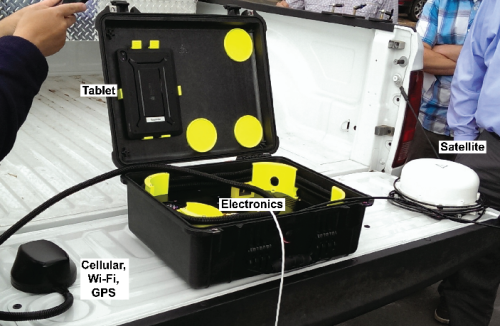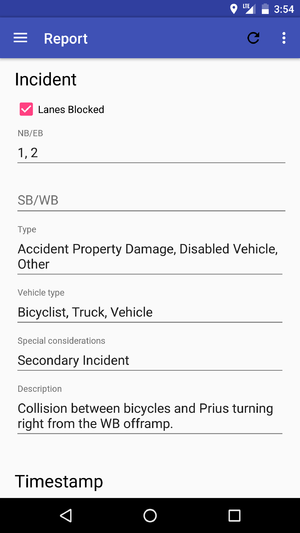
Responder
| Benefit |
Allows first responders to provide information to get the right equipment and personnel dispatched to the site. This product effectively utilizes resources. |
AHMCT researchers have finalized the third generation of the Responder system, a communication tool that integrates hardware, software, and communications to provide incident responders, particularly those in rural areas with sparse communication coverage, with an easy to use means to accurately collect and communicate at-scene information with their managers and the TMC.
Motivation
Caltrans maintenance staff is a first responder to incidents on the state roadways. They must collect information, determine the appropriate response, and access and manage resources at-scene. Caltrans currently does not have an efficient means to collect at-scene incident information and share this information with their transportation management center (TMC) and other emergency responders. In most districts, emergency responders rely on voice communications to exchange information. However, Caltrans rural districts lack the ability to distribute incident support information to responders via data networks. Such information could better prepare responders for incident support, provide assistance for incident management, and guide responders in making safe and sound decisions. These rural districts have areas with no communication availability including no two-way radio communication and/or cellular coverage. Caltrans needs a communication tool for first responders to allow photos, drawings, weather information, and maps to be shared between responders and a TMC during an incident via cellular, satellite, or other forms of communications, that will work anywhere in the State.
Responder System Overview
The researchers at the UC Davis Advanced Highway Maintenance and Construction Technology Research Center (AHMCT) developed the third generation of the Responder system. This is a prototype communication tool that integrates hardware, software and communications to provide incident responders, particularly those in rural areas, with sparse communication coverage, with an easy to use means to accurately collect and communicate at-scene information with their managers and the TMC. The incident responder uses a smart device such as a tablet or cell phone to operate the Responder system.

Unique features of Responder include the ability for users to capture, annotate, and transmit images. Using Global Positioning System (GPS) readings, the system automatically downloads local weather data, retrieves maps and aerial photos, and pinpoints the responder’s location on the maps. By simply clicking on the “Send Email” button, an email message is automatically composed and sent to the TMC operator or other parties. The system connects to the most efficient and available service (cellular, satellite, or other) on its own. The system uses cellular service where it can and satellite service in areas with no other communication coverage. The system allows responders to concentrate on work at the scene without burdening them with data input and reporting.



Summary
The Responder system allows first responders to collect and share at-scene information quickly and efficiently. It is especially valuable in:
• Major incidents such as landslides, floods and earthquakes, where the damage could be extensive.
• Remote rural areas where communication is often limited to voice, and coverage is sparse.
• When the first responder is new or inexperienced in responding to certain situations.
Responder effectively utilizes resources by:
• Supporting the ability to evaluate what is happening at the scene from a maintenance station or TMC without extended delay.
• Sending correct employees and equipment to the incident based on initial information that can be seen in the photo(s) and/or report(s) submitted by staff at the incident scene.
• Providing real-time information to other staff, such as Public Information Office (PIO), who may have to answer to outside agencies regarding what is happening at the incident.

What Do the Researchers Recommend
The researchers recommend enterprise-wide deployment of the Responder system, based on Caltrans’ recent successfully completed field testing. The system provides significant benefits. Commercial hardware is now readily available to support wide deployment without a need for customized hardware.
For Additional Information
| Melissa Clark Caltrans Project Manager |
melissa_clark (at) dot.ca.gov, | (916) 227-4172 |
| Jeremiah Pearce
Caltrans Technical Advisory Group Leader |
jeremiah_pearce (at) dot.ca.gov | (530) 225-3438 |
| Ty A. Lasky Principal Investigator |
talasky (at) ucdavis.e du | (530) 752-6366 |
| Stephen Donecker Lead engineer |
smdonecker (at) ucdavis.edu | (530) 752-7946 |
This document is disseminated in the interest of information exchange. The contents do not necessarily reflect the official views or policies of the AHMCT Research Center, the University of California, the State of California, or the Federal Highway Administration. This document does not constitute a standard, specification, regulation, or imply endorsement of the conclusions or recommendations.
